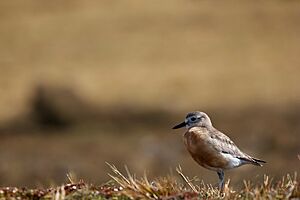Southern New Zealand dotterel facts for kids
Quick facts for kids Charadrius obscurus obscurus |
|
|---|---|
 |
|
| Southern New Zealand dotterel on its breeding grounds on hills of Tin Range in Stewart Island | |
| Conservation status | |
 Nationally Critical (NZ TCS) |
|
| Scientific classification |
|
| Kingdom: | Animalia |
| Phylum: | Chordata |
| Class: | Aves |
| Order: | Charadriiformes |
| Family: | Charadriidae |
| Genus: | Charadrius |
| Species: |
C. obscurus
|
| Subspecies: |
C. o. obscurus
|
| Trinomial name | |
| Charadrius obscurus obscurus Gmelin, 1789
|
|
The southern New Zealand dotterel (also called the southern red-breasted plover) is a special type of bird found only in New Zealand. Its scientific name is Charadrius obscurus obscurus. This bird is a critically endangered subspecies of the New Zealand dotterel. This means it's in great danger of disappearing forever. These shorebirds used to live all over the South Island. Now, they mostly make their nests and raise their young on Stewart Island.
What Makes Them Special?
For a long time, the southern New Zealand dotterel and the northern New Zealand dotterel were thought to be the same kind of bird. They were both called the New Zealand dotterel.
But scientists studied them closely. They found many differences between the two subspecies. For example, the southern dotterel is much bigger and heavier.
The places they live also made them different. Strong winds on the South Island might have given the southern dotterel a longer middle toe and claw. This helps them hold on better.
Their habits are different too. The northern dotterel likes sandy beaches. But the southern dotterel prefers to build its nests inland. In winter, it moves to the beaches of the South Island. Because of these differences, scientists decided in 2014 that they were separate subspecies.
Where Do They Live?
The southern New Zealand dotterel used to live all over the South Island. Today, you can mostly find them on Stewart Island.
On Stewart Island, they build their nests in many different places. They live on mountain tops, flat plains, and even in wetlands away from the coast. You can also find them in areas where the ocean meets the land (marine intertidal) and in river valleys. They live at heights up to 1,000 meters (about 3,280 feet) above sea level.
Why Are They in Danger?
The southern New Zealand dotterel is a critically endangered bird. This means its population is very small and getting smaller. There are only about 60 to 80 adult birds left.
Most of these birds disappeared from the South Island. This happened because of animals brought to New Zealand by people. These include feral cats and stoats. These predators hunt and kill the dotterels.
In 1992, there were only 62 southern dotterels left. Their numbers slowly grew to 290 birds by 2010. But since then, the population has dropped again. In April 2023, there were only about 126 birds.
The problem isn't that baby birds aren't being born. It's that adult birds are dying too quickly. Feral cats are a big reason for this. About 40 to 50 birds died during the 2022–2023 nesting season. These birds can live for about 20 years. But now, about 80% of them die within 5 years because of predators.


